Author Position in Co-Authorships: Perceptions & Promotion within ACIS
VerifiedAdded on 2021/06/16
|16
|4705
|179
Report
AI Summary
This research proposal explores the impact of author order in co-authored research articles on the perceptions of contribution, seniority, and promotion within the ACIS community. It addresses the increasing prevalence of co-authorship and the challenges in determining individual contributions, particularly in interdisciplinary research. The study uses a descriptive research design, employing questionnaires and statistical analysis to investigate how author ranking influences peer reviewers' perceptions and promotion decisions. The conceptual framework is based on the planned theory of behavior, suggesting that perceptions of author seniority and contribution, influenced by author order, affect tenure and promotion decisions. The report reviews existing literature on co-authorship trends, challenges, and the significance of author order in academic recognition, addressing issues like author inflation and the need for clear authorship criteria. The ultimate goal is to understand and quantify the impact of author position on academic career progression within the ACIS community.
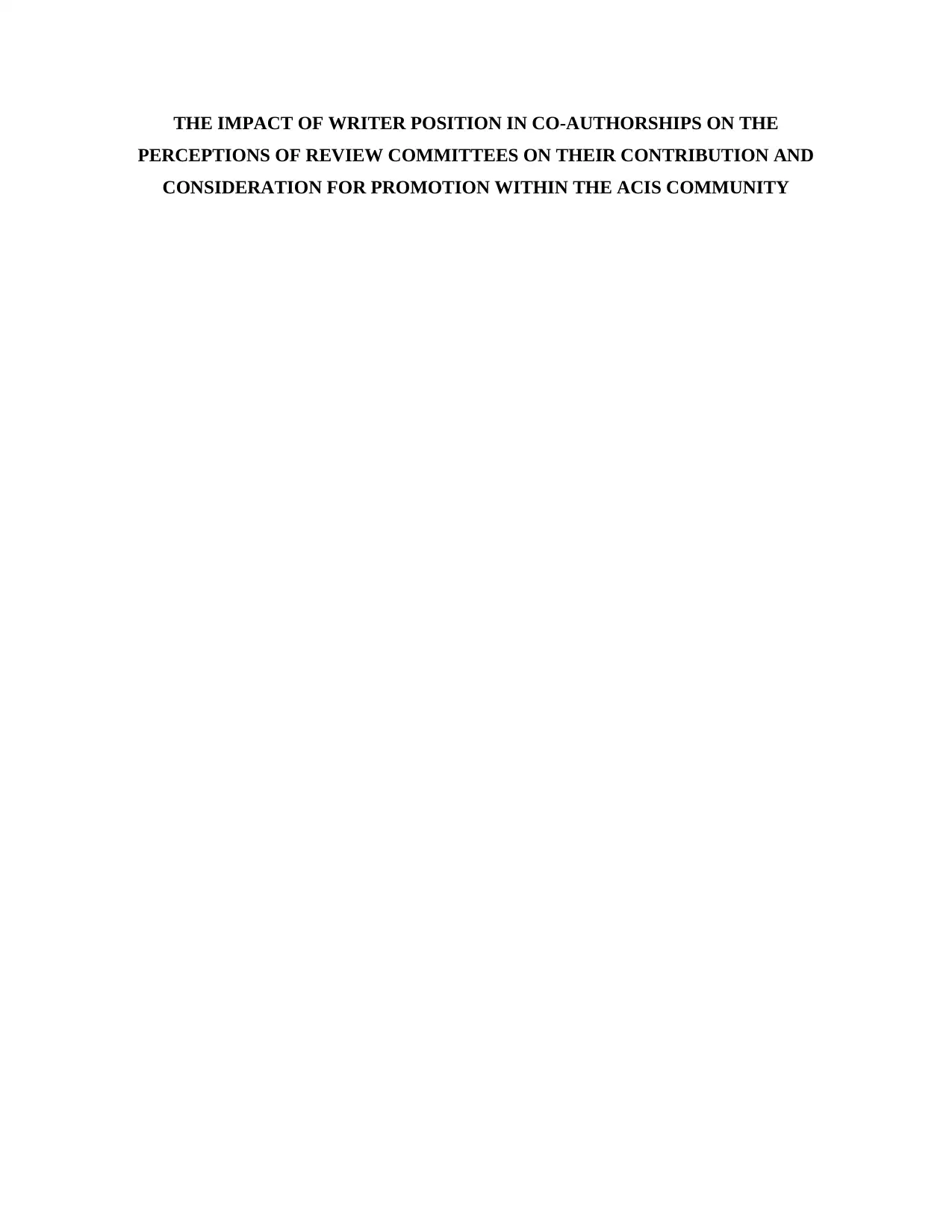
THE IMPACT OF WRITER POSITION IN CO-AUTHORSHIPS ON THE
PERCEPTIONS OF REVIEW COMMITTEES ON THEIR CONTRIBUTION AND
CONSIDERATION FOR PROMOTION WITHIN THE ACIS COMMUNITY
PERCEPTIONS OF REVIEW COMMITTEES ON THEIR CONTRIBUTION AND
CONSIDERATION FOR PROMOTION WITHIN THE ACIS COMMUNITY
Paraphrase This Document
Need a fresh take? Get an instant paraphrase of this document with our AI Paraphraser
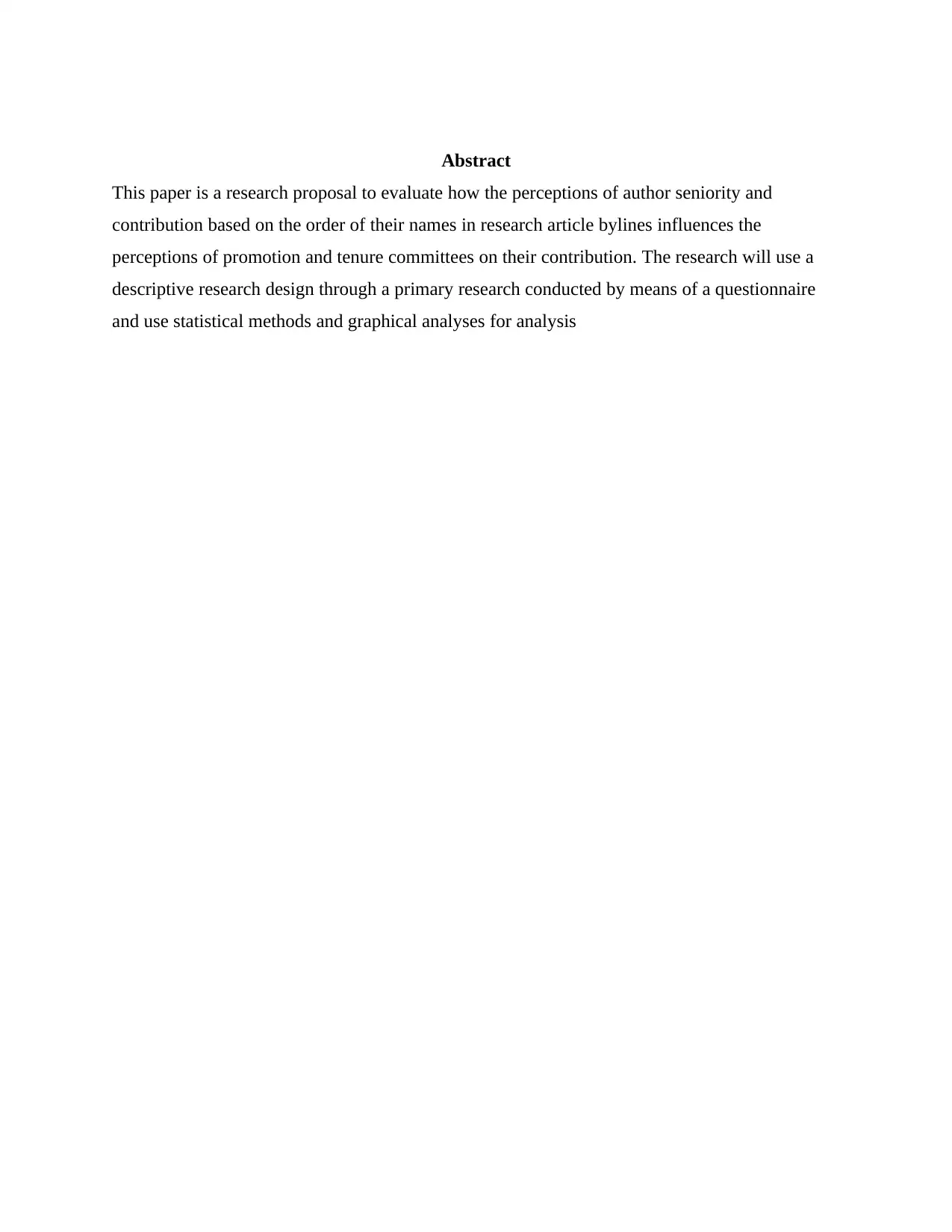
Abstract
This paper is a research proposal to evaluate how the perceptions of author seniority and
contribution based on the order of their names in research article bylines influences the
perceptions of promotion and tenure committees on their contribution. The research will use a
descriptive research design through a primary research conducted by means of a questionnaire
and use statistical methods and graphical analyses for analysis
This paper is a research proposal to evaluate how the perceptions of author seniority and
contribution based on the order of their names in research article bylines influences the
perceptions of promotion and tenure committees on their contribution. The research will use a
descriptive research design through a primary research conducted by means of a questionnaire
and use statistical methods and graphical analyses for analysis
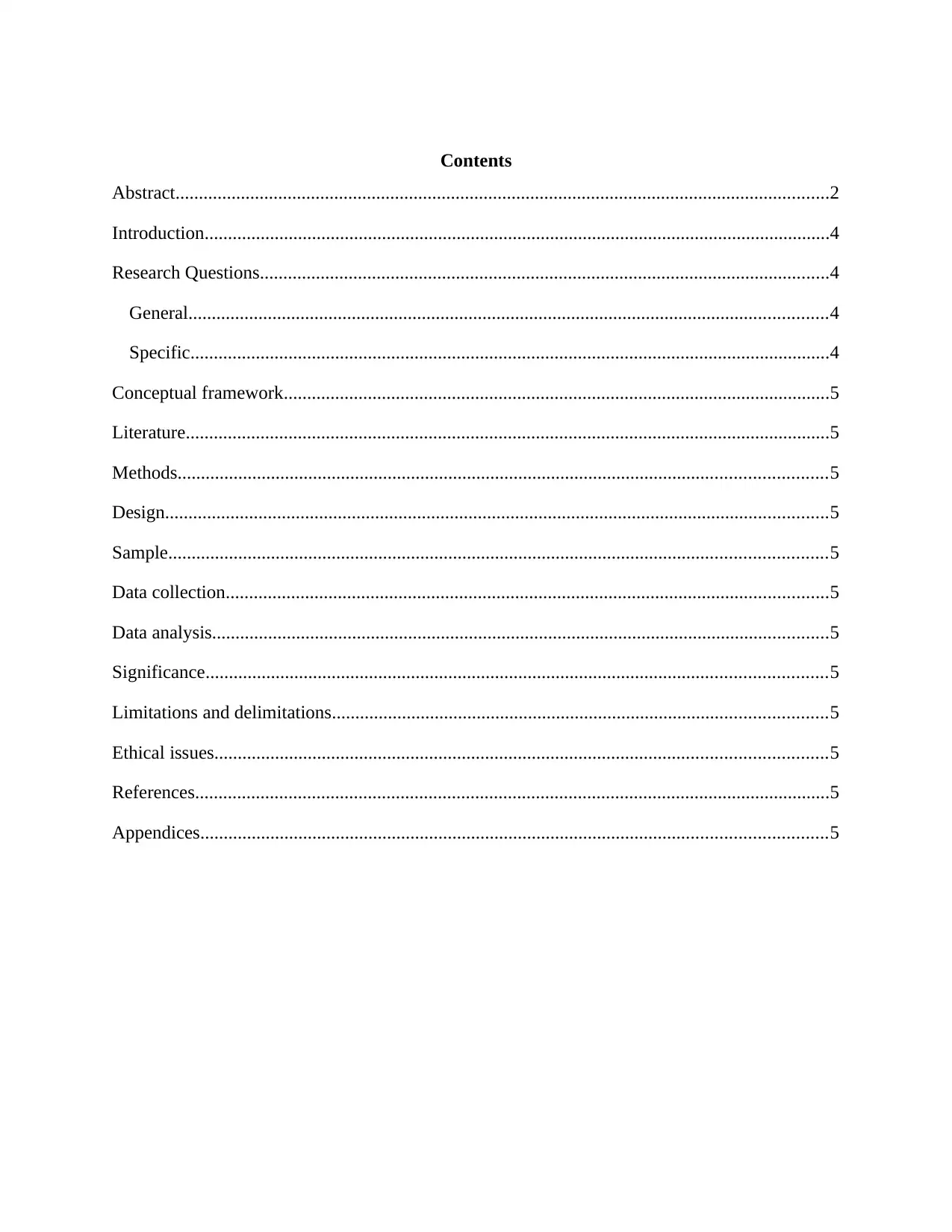
Contents
Abstract............................................................................................................................................2
Introduction......................................................................................................................................4
Research Questions..........................................................................................................................4
General.........................................................................................................................................4
Specific.........................................................................................................................................4
Conceptual framework.....................................................................................................................5
Literature..........................................................................................................................................5
Methods...........................................................................................................................................5
Design..............................................................................................................................................5
Sample.............................................................................................................................................5
Data collection.................................................................................................................................5
Data analysis....................................................................................................................................5
Significance.....................................................................................................................................5
Limitations and delimitations..........................................................................................................5
Ethical issues...................................................................................................................................5
References........................................................................................................................................5
Appendices......................................................................................................................................5
Abstract............................................................................................................................................2
Introduction......................................................................................................................................4
Research Questions..........................................................................................................................4
General.........................................................................................................................................4
Specific.........................................................................................................................................4
Conceptual framework.....................................................................................................................5
Literature..........................................................................................................................................5
Methods...........................................................................................................................................5
Design..............................................................................................................................................5
Sample.............................................................................................................................................5
Data collection.................................................................................................................................5
Data analysis....................................................................................................................................5
Significance.....................................................................................................................................5
Limitations and delimitations..........................................................................................................5
Ethical issues...................................................................................................................................5
References........................................................................................................................................5
Appendices......................................................................................................................................5
⊘ This is a preview!⊘
Do you want full access?
Subscribe today to unlock all pages.

Trusted by 1+ million students worldwide
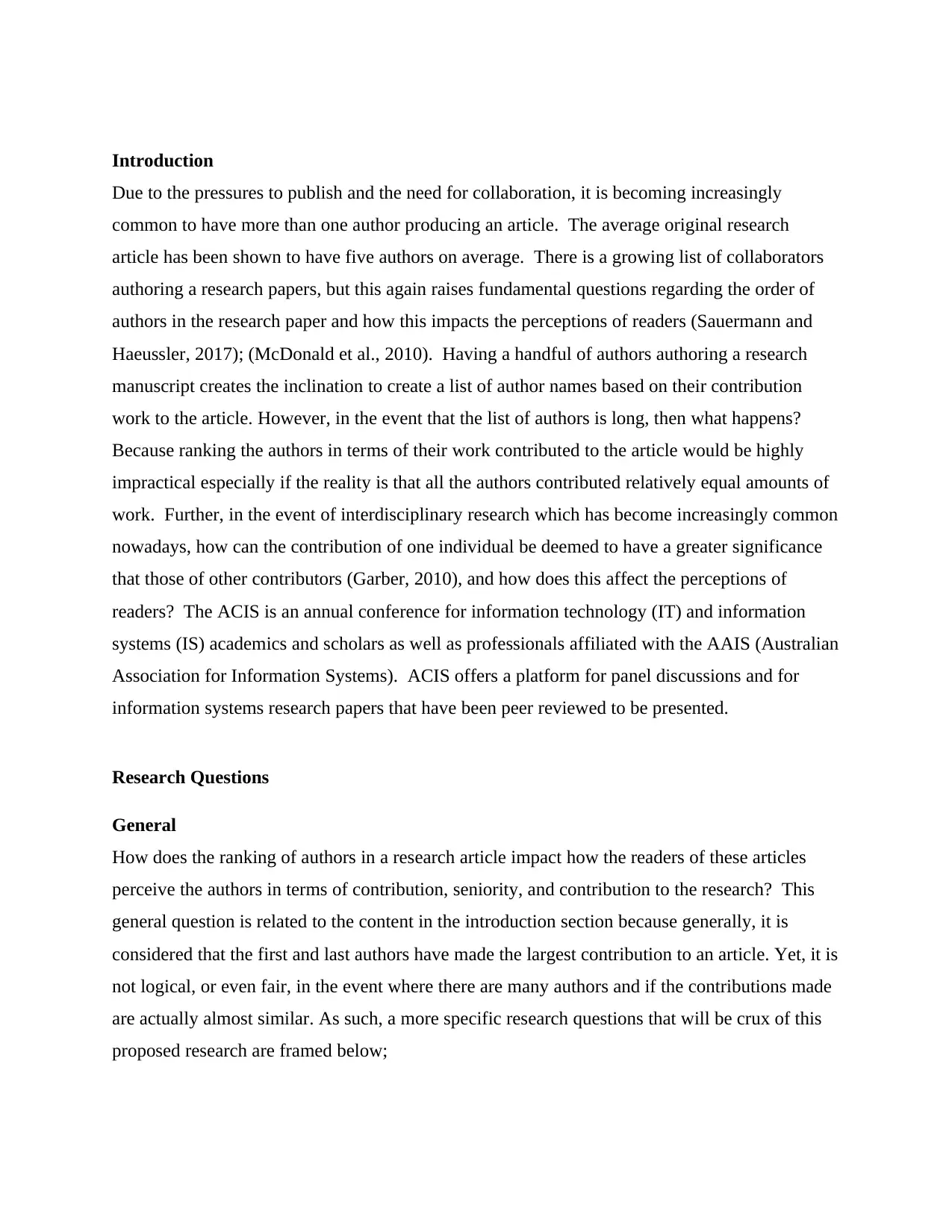
Introduction
Due to the pressures to publish and the need for collaboration, it is becoming increasingly
common to have more than one author producing an article. The average original research
article has been shown to have five authors on average. There is a growing list of collaborators
authoring a research papers, but this again raises fundamental questions regarding the order of
authors in the research paper and how this impacts the perceptions of readers (Sauermann and
Haeussler, 2017); (McDonald et al., 2010). Having a handful of authors authoring a research
manuscript creates the inclination to create a list of author names based on their contribution
work to the article. However, in the event that the list of authors is long, then what happens?
Because ranking the authors in terms of their work contributed to the article would be highly
impractical especially if the reality is that all the authors contributed relatively equal amounts of
work. Further, in the event of interdisciplinary research which has become increasingly common
nowadays, how can the contribution of one individual be deemed to have a greater significance
that those of other contributors (Garber, 2010), and how does this affect the perceptions of
readers? The ACIS is an annual conference for information technology (IT) and information
systems (IS) academics and scholars as well as professionals affiliated with the AAIS (Australian
Association for Information Systems). ACIS offers a platform for panel discussions and for
information systems research papers that have been peer reviewed to be presented.
Research Questions
General
How does the ranking of authors in a research article impact how the readers of these articles
perceive the authors in terms of contribution, seniority, and contribution to the research? This
general question is related to the content in the introduction section because generally, it is
considered that the first and last authors have made the largest contribution to an article. Yet, it is
not logical, or even fair, in the event where there are many authors and if the contributions made
are actually almost similar. As such, a more specific research questions that will be crux of this
proposed research are framed below;
Due to the pressures to publish and the need for collaboration, it is becoming increasingly
common to have more than one author producing an article. The average original research
article has been shown to have five authors on average. There is a growing list of collaborators
authoring a research papers, but this again raises fundamental questions regarding the order of
authors in the research paper and how this impacts the perceptions of readers (Sauermann and
Haeussler, 2017); (McDonald et al., 2010). Having a handful of authors authoring a research
manuscript creates the inclination to create a list of author names based on their contribution
work to the article. However, in the event that the list of authors is long, then what happens?
Because ranking the authors in terms of their work contributed to the article would be highly
impractical especially if the reality is that all the authors contributed relatively equal amounts of
work. Further, in the event of interdisciplinary research which has become increasingly common
nowadays, how can the contribution of one individual be deemed to have a greater significance
that those of other contributors (Garber, 2010), and how does this affect the perceptions of
readers? The ACIS is an annual conference for information technology (IT) and information
systems (IS) academics and scholars as well as professionals affiliated with the AAIS (Australian
Association for Information Systems). ACIS offers a platform for panel discussions and for
information systems research papers that have been peer reviewed to be presented.
Research Questions
General
How does the ranking of authors in a research article impact how the readers of these articles
perceive the authors in terms of contribution, seniority, and contribution to the research? This
general question is related to the content in the introduction section because generally, it is
considered that the first and last authors have made the largest contribution to an article. Yet, it is
not logical, or even fair, in the event where there are many authors and if the contributions made
are actually almost similar. As such, a more specific research questions that will be crux of this
proposed research are framed below;
Paraphrase This Document
Need a fresh take? Get an instant paraphrase of this document with our AI Paraphraser
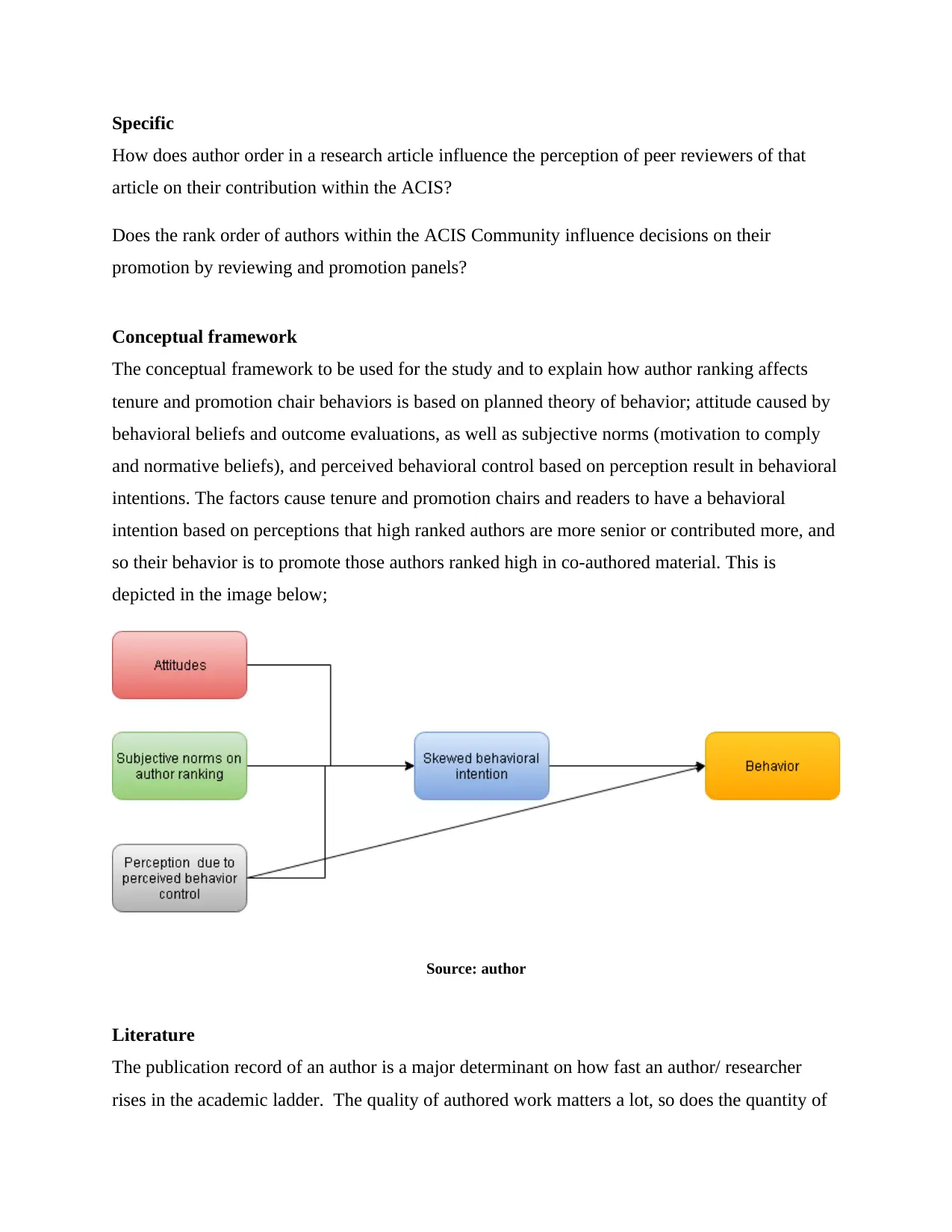
Specific
How does author order in a research article influence the perception of peer reviewers of that
article on their contribution within the ACIS?
Does the rank order of authors within the ACIS Community influence decisions on their
promotion by reviewing and promotion panels?
Conceptual framework
The conceptual framework to be used for the study and to explain how author ranking affects
tenure and promotion chair behaviors is based on planned theory of behavior; attitude caused by
behavioral beliefs and outcome evaluations, as well as subjective norms (motivation to comply
and normative beliefs), and perceived behavioral control based on perception result in behavioral
intentions. The factors cause tenure and promotion chairs and readers to have a behavioral
intention based on perceptions that high ranked authors are more senior or contributed more, and
so their behavior is to promote those authors ranked high in co-authored material. This is
depicted in the image below;
Source: author
Literature
The publication record of an author is a major determinant on how fast an author/ researcher
rises in the academic ladder. The quality of authored work matters a lot, so does the quantity of
How does author order in a research article influence the perception of peer reviewers of that
article on their contribution within the ACIS?
Does the rank order of authors within the ACIS Community influence decisions on their
promotion by reviewing and promotion panels?
Conceptual framework
The conceptual framework to be used for the study and to explain how author ranking affects
tenure and promotion chair behaviors is based on planned theory of behavior; attitude caused by
behavioral beliefs and outcome evaluations, as well as subjective norms (motivation to comply
and normative beliefs), and perceived behavioral control based on perception result in behavioral
intentions. The factors cause tenure and promotion chairs and readers to have a behavioral
intention based on perceptions that high ranked authors are more senior or contributed more, and
so their behavior is to promote those authors ranked high in co-authored material. This is
depicted in the image below;
Source: author
Literature
The publication record of an author is a major determinant on how fast an author/ researcher
rises in the academic ladder. The quality of authored work matters a lot, so does the quantity of
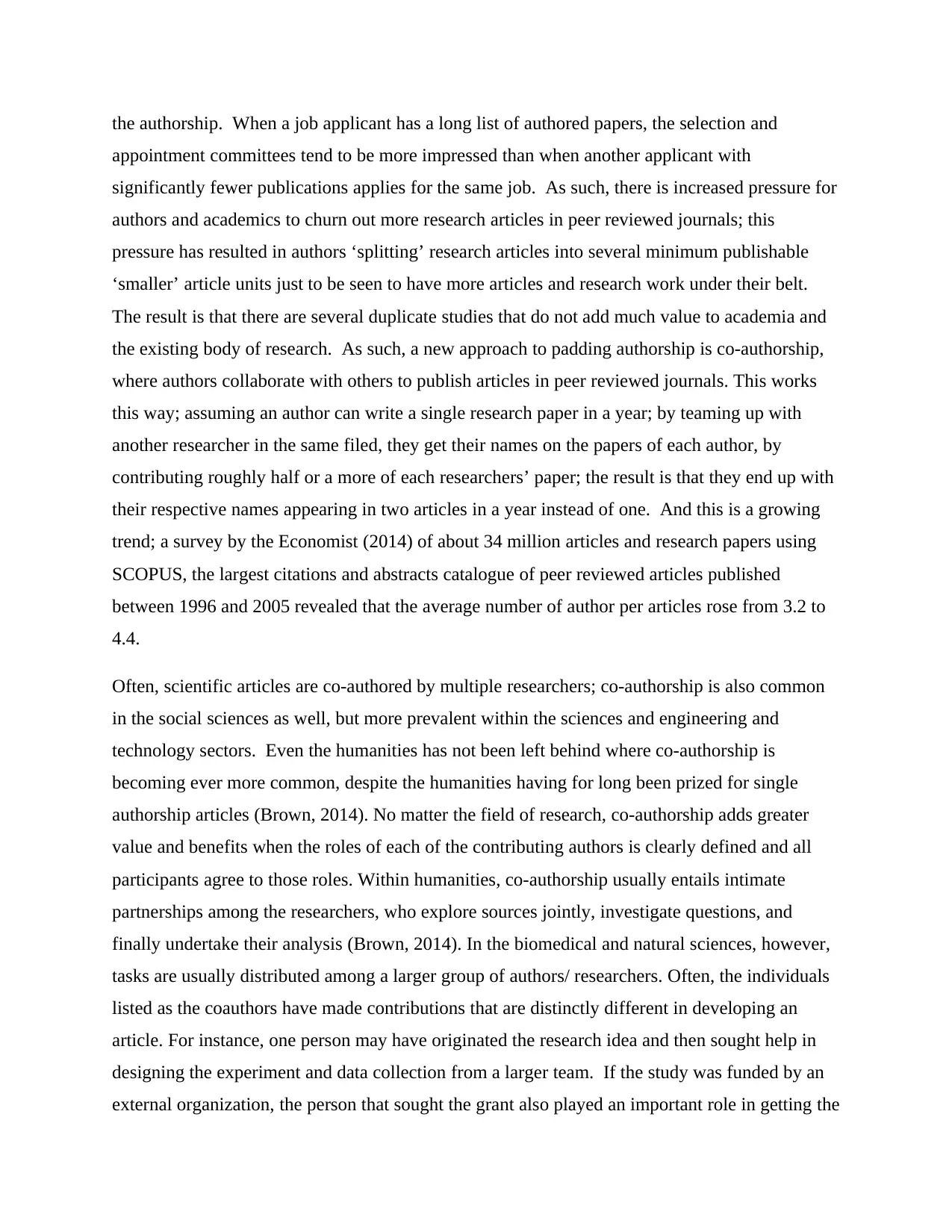
the authorship. When a job applicant has a long list of authored papers, the selection and
appointment committees tend to be more impressed than when another applicant with
significantly fewer publications applies for the same job. As such, there is increased pressure for
authors and academics to churn out more research articles in peer reviewed journals; this
pressure has resulted in authors ‘splitting’ research articles into several minimum publishable
‘smaller’ article units just to be seen to have more articles and research work under their belt.
The result is that there are several duplicate studies that do not add much value to academia and
the existing body of research. As such, a new approach to padding authorship is co-authorship,
where authors collaborate with others to publish articles in peer reviewed journals. This works
this way; assuming an author can write a single research paper in a year; by teaming up with
another researcher in the same filed, they get their names on the papers of each author, by
contributing roughly half or a more of each researchers’ paper; the result is that they end up with
their respective names appearing in two articles in a year instead of one. And this is a growing
trend; a survey by the Economist (2014) of about 34 million articles and research papers using
SCOPUS, the largest citations and abstracts catalogue of peer reviewed articles published
between 1996 and 2005 revealed that the average number of author per articles rose from 3.2 to
4.4.
Often, scientific articles are co-authored by multiple researchers; co-authorship is also common
in the social sciences as well, but more prevalent within the sciences and engineering and
technology sectors. Even the humanities has not been left behind where co-authorship is
becoming ever more common, despite the humanities having for long been prized for single
authorship articles (Brown, 2014). No matter the field of research, co-authorship adds greater
value and benefits when the roles of each of the contributing authors is clearly defined and all
participants agree to those roles. Within humanities, co-authorship usually entails intimate
partnerships among the researchers, who explore sources jointly, investigate questions, and
finally undertake their analysis (Brown, 2014). In the biomedical and natural sciences, however,
tasks are usually distributed among a larger group of authors/ researchers. Often, the individuals
listed as the coauthors have made contributions that are distinctly different in developing an
article. For instance, one person may have originated the research idea and then sought help in
designing the experiment and data collection from a larger team. If the study was funded by an
external organization, the person that sought the grant also played an important role in getting the
appointment committees tend to be more impressed than when another applicant with
significantly fewer publications applies for the same job. As such, there is increased pressure for
authors and academics to churn out more research articles in peer reviewed journals; this
pressure has resulted in authors ‘splitting’ research articles into several minimum publishable
‘smaller’ article units just to be seen to have more articles and research work under their belt.
The result is that there are several duplicate studies that do not add much value to academia and
the existing body of research. As such, a new approach to padding authorship is co-authorship,
where authors collaborate with others to publish articles in peer reviewed journals. This works
this way; assuming an author can write a single research paper in a year; by teaming up with
another researcher in the same filed, they get their names on the papers of each author, by
contributing roughly half or a more of each researchers’ paper; the result is that they end up with
their respective names appearing in two articles in a year instead of one. And this is a growing
trend; a survey by the Economist (2014) of about 34 million articles and research papers using
SCOPUS, the largest citations and abstracts catalogue of peer reviewed articles published
between 1996 and 2005 revealed that the average number of author per articles rose from 3.2 to
4.4.
Often, scientific articles are co-authored by multiple researchers; co-authorship is also common
in the social sciences as well, but more prevalent within the sciences and engineering and
technology sectors. Even the humanities has not been left behind where co-authorship is
becoming ever more common, despite the humanities having for long been prized for single
authorship articles (Brown, 2014). No matter the field of research, co-authorship adds greater
value and benefits when the roles of each of the contributing authors is clearly defined and all
participants agree to those roles. Within humanities, co-authorship usually entails intimate
partnerships among the researchers, who explore sources jointly, investigate questions, and
finally undertake their analysis (Brown, 2014). In the biomedical and natural sciences, however,
tasks are usually distributed among a larger group of authors/ researchers. Often, the individuals
listed as the coauthors have made contributions that are distinctly different in developing an
article. For instance, one person may have originated the research idea and then sought help in
designing the experiment and data collection from a larger team. If the study was funded by an
external organization, the person that sought the grant also played an important role in getting the
⊘ This is a preview!⊘
Do you want full access?
Subscribe today to unlock all pages.

Trusted by 1+ million students worldwide
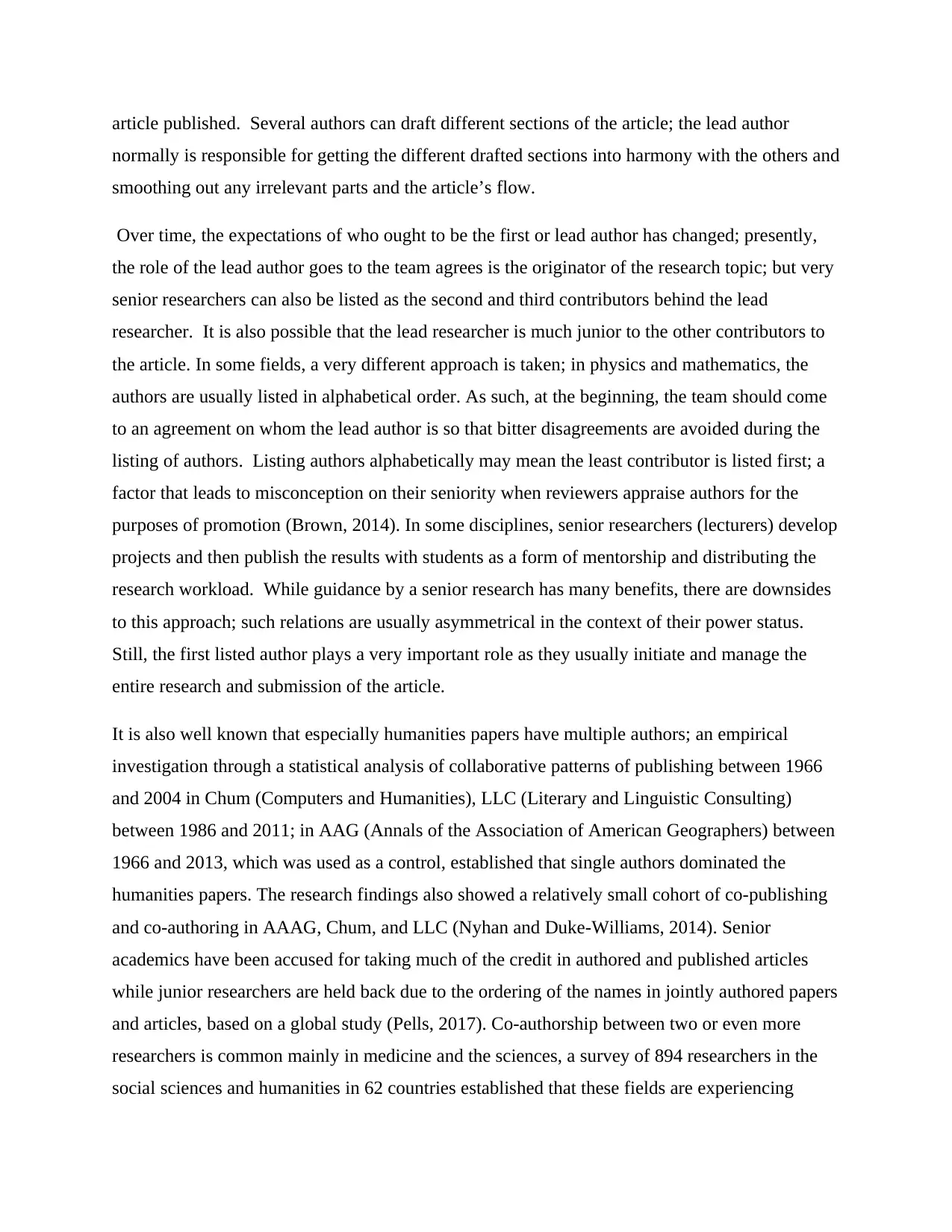
article published. Several authors can draft different sections of the article; the lead author
normally is responsible for getting the different drafted sections into harmony with the others and
smoothing out any irrelevant parts and the article’s flow.
Over time, the expectations of who ought to be the first or lead author has changed; presently,
the role of the lead author goes to the team agrees is the originator of the research topic; but very
senior researchers can also be listed as the second and third contributors behind the lead
researcher. It is also possible that the lead researcher is much junior to the other contributors to
the article. In some fields, a very different approach is taken; in physics and mathematics, the
authors are usually listed in alphabetical order. As such, at the beginning, the team should come
to an agreement on whom the lead author is so that bitter disagreements are avoided during the
listing of authors. Listing authors alphabetically may mean the least contributor is listed first; a
factor that leads to misconception on their seniority when reviewers appraise authors for the
purposes of promotion (Brown, 2014). In some disciplines, senior researchers (lecturers) develop
projects and then publish the results with students as a form of mentorship and distributing the
research workload. While guidance by a senior research has many benefits, there are downsides
to this approach; such relations are usually asymmetrical in the context of their power status.
Still, the first listed author plays a very important role as they usually initiate and manage the
entire research and submission of the article.
It is also well known that especially humanities papers have multiple authors; an empirical
investigation through a statistical analysis of collaborative patterns of publishing between 1966
and 2004 in Chum (Computers and Humanities), LLC (Literary and Linguistic Consulting)
between 1986 and 2011; in AAG (Annals of the Association of American Geographers) between
1966 and 2013, which was used as a control, established that single authors dominated the
humanities papers. The research findings also showed a relatively small cohort of co-publishing
and co-authoring in AAAG, Chum, and LLC (Nyhan and Duke-Williams, 2014). Senior
academics have been accused for taking much of the credit in authored and published articles
while junior researchers are held back due to the ordering of the names in jointly authored papers
and articles, based on a global study (Pells, 2017). Co-authorship between two or even more
researchers is common mainly in medicine and the sciences, a survey of 894 researchers in the
social sciences and humanities in 62 countries established that these fields are experiencing
normally is responsible for getting the different drafted sections into harmony with the others and
smoothing out any irrelevant parts and the article’s flow.
Over time, the expectations of who ought to be the first or lead author has changed; presently,
the role of the lead author goes to the team agrees is the originator of the research topic; but very
senior researchers can also be listed as the second and third contributors behind the lead
researcher. It is also possible that the lead researcher is much junior to the other contributors to
the article. In some fields, a very different approach is taken; in physics and mathematics, the
authors are usually listed in alphabetical order. As such, at the beginning, the team should come
to an agreement on whom the lead author is so that bitter disagreements are avoided during the
listing of authors. Listing authors alphabetically may mean the least contributor is listed first; a
factor that leads to misconception on their seniority when reviewers appraise authors for the
purposes of promotion (Brown, 2014). In some disciplines, senior researchers (lecturers) develop
projects and then publish the results with students as a form of mentorship and distributing the
research workload. While guidance by a senior research has many benefits, there are downsides
to this approach; such relations are usually asymmetrical in the context of their power status.
Still, the first listed author plays a very important role as they usually initiate and manage the
entire research and submission of the article.
It is also well known that especially humanities papers have multiple authors; an empirical
investigation through a statistical analysis of collaborative patterns of publishing between 1966
and 2004 in Chum (Computers and Humanities), LLC (Literary and Linguistic Consulting)
between 1986 and 2011; in AAG (Annals of the Association of American Geographers) between
1966 and 2013, which was used as a control, established that single authors dominated the
humanities papers. The research findings also showed a relatively small cohort of co-publishing
and co-authoring in AAAG, Chum, and LLC (Nyhan and Duke-Williams, 2014). Senior
academics have been accused for taking much of the credit in authored and published articles
while junior researchers are held back due to the ordering of the names in jointly authored papers
and articles, based on a global study (Pells, 2017). Co-authorship between two or even more
researchers is common mainly in medicine and the sciences, a survey of 894 researchers in the
social sciences and humanities in 62 countries established that these fields are experiencing
Paraphrase This Document
Need a fresh take? Get an instant paraphrase of this document with our AI Paraphraser
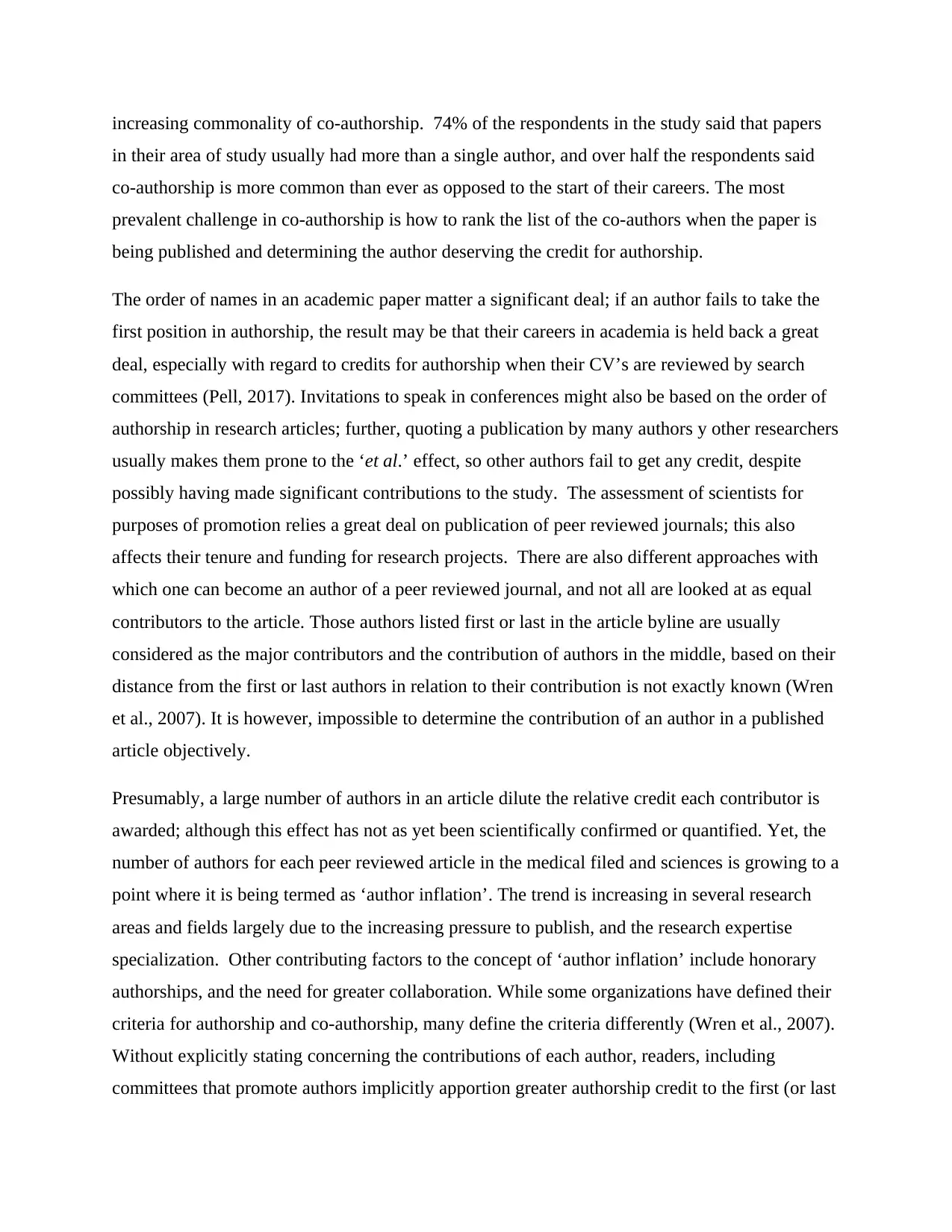
increasing commonality of co-authorship. 74% of the respondents in the study said that papers
in their area of study usually had more than a single author, and over half the respondents said
co-authorship is more common than ever as opposed to the start of their careers. The most
prevalent challenge in co-authorship is how to rank the list of the co-authors when the paper is
being published and determining the author deserving the credit for authorship.
The order of names in an academic paper matter a significant deal; if an author fails to take the
first position in authorship, the result may be that their careers in academia is held back a great
deal, especially with regard to credits for authorship when their CV’s are reviewed by search
committees (Pell, 2017). Invitations to speak in conferences might also be based on the order of
authorship in research articles; further, quoting a publication by many authors y other researchers
usually makes them prone to the ‘et al.’ effect, so other authors fail to get any credit, despite
possibly having made significant contributions to the study. The assessment of scientists for
purposes of promotion relies a great deal on publication of peer reviewed journals; this also
affects their tenure and funding for research projects. There are also different approaches with
which one can become an author of a peer reviewed journal, and not all are looked at as equal
contributors to the article. Those authors listed first or last in the article byline are usually
considered as the major contributors and the contribution of authors in the middle, based on their
distance from the first or last authors in relation to their contribution is not exactly known (Wren
et al., 2007). It is however, impossible to determine the contribution of an author in a published
article objectively.
Presumably, a large number of authors in an article dilute the relative credit each contributor is
awarded; although this effect has not as yet been scientifically confirmed or quantified. Yet, the
number of authors for each peer reviewed article in the medical filed and sciences is growing to a
point where it is being termed as ‘author inflation’. The trend is increasing in several research
areas and fields largely due to the increasing pressure to publish, and the research expertise
specialization. Other contributing factors to the concept of ‘author inflation’ include honorary
authorships, and the need for greater collaboration. While some organizations have defined their
criteria for authorship and co-authorship, many define the criteria differently (Wren et al., 2007).
Without explicitly stating concerning the contributions of each author, readers, including
committees that promote authors implicitly apportion greater authorship credit to the first (or last
in their area of study usually had more than a single author, and over half the respondents said
co-authorship is more common than ever as opposed to the start of their careers. The most
prevalent challenge in co-authorship is how to rank the list of the co-authors when the paper is
being published and determining the author deserving the credit for authorship.
The order of names in an academic paper matter a significant deal; if an author fails to take the
first position in authorship, the result may be that their careers in academia is held back a great
deal, especially with regard to credits for authorship when their CV’s are reviewed by search
committees (Pell, 2017). Invitations to speak in conferences might also be based on the order of
authorship in research articles; further, quoting a publication by many authors y other researchers
usually makes them prone to the ‘et al.’ effect, so other authors fail to get any credit, despite
possibly having made significant contributions to the study. The assessment of scientists for
purposes of promotion relies a great deal on publication of peer reviewed journals; this also
affects their tenure and funding for research projects. There are also different approaches with
which one can become an author of a peer reviewed journal, and not all are looked at as equal
contributors to the article. Those authors listed first or last in the article byline are usually
considered as the major contributors and the contribution of authors in the middle, based on their
distance from the first or last authors in relation to their contribution is not exactly known (Wren
et al., 2007). It is however, impossible to determine the contribution of an author in a published
article objectively.
Presumably, a large number of authors in an article dilute the relative credit each contributor is
awarded; although this effect has not as yet been scientifically confirmed or quantified. Yet, the
number of authors for each peer reviewed article in the medical filed and sciences is growing to a
point where it is being termed as ‘author inflation’. The trend is increasing in several research
areas and fields largely due to the increasing pressure to publish, and the research expertise
specialization. Other contributing factors to the concept of ‘author inflation’ include honorary
authorships, and the need for greater collaboration. While some organizations have defined their
criteria for authorship and co-authorship, many define the criteria differently (Wren et al., 2007).
Without explicitly stating concerning the contributions of each author, readers, including
committees that promote authors implicitly apportion greater authorship credit to the first (or last
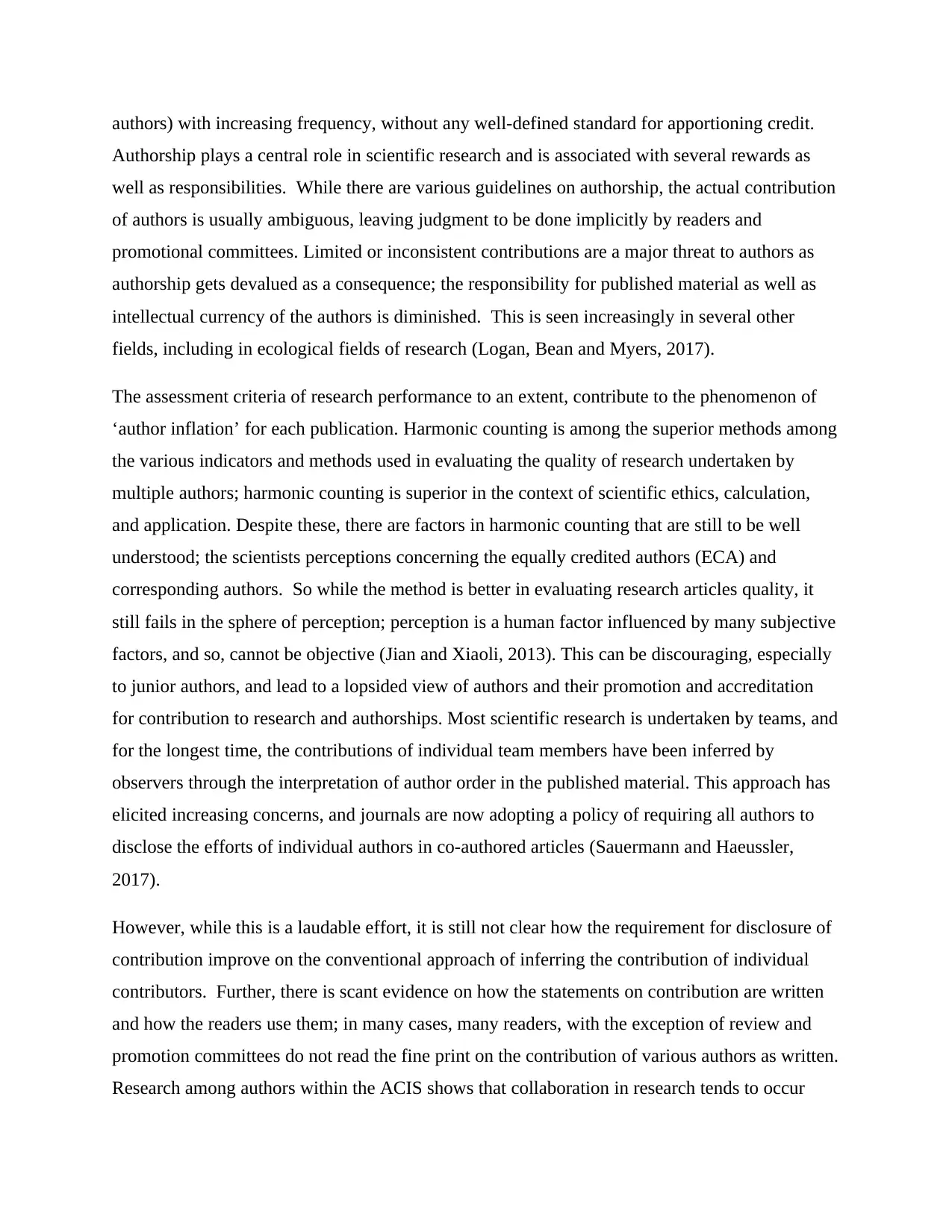
authors) with increasing frequency, without any well-defined standard for apportioning credit.
Authorship plays a central role in scientific research and is associated with several rewards as
well as responsibilities. While there are various guidelines on authorship, the actual contribution
of authors is usually ambiguous, leaving judgment to be done implicitly by readers and
promotional committees. Limited or inconsistent contributions are a major threat to authors as
authorship gets devalued as a consequence; the responsibility for published material as well as
intellectual currency of the authors is diminished. This is seen increasingly in several other
fields, including in ecological fields of research (Logan, Bean and Myers, 2017).
The assessment criteria of research performance to an extent, contribute to the phenomenon of
‘author inflation’ for each publication. Harmonic counting is among the superior methods among
the various indicators and methods used in evaluating the quality of research undertaken by
multiple authors; harmonic counting is superior in the context of scientific ethics, calculation,
and application. Despite these, there are factors in harmonic counting that are still to be well
understood; the scientists perceptions concerning the equally credited authors (ECA) and
corresponding authors. So while the method is better in evaluating research articles quality, it
still fails in the sphere of perception; perception is a human factor influenced by many subjective
factors, and so, cannot be objective (Jian and Xiaoli, 2013). This can be discouraging, especially
to junior authors, and lead to a lopsided view of authors and their promotion and accreditation
for contribution to research and authorships. Most scientific research is undertaken by teams, and
for the longest time, the contributions of individual team members have been inferred by
observers through the interpretation of author order in the published material. This approach has
elicited increasing concerns, and journals are now adopting a policy of requiring all authors to
disclose the efforts of individual authors in co-authored articles (Sauermann and Haeussler,
2017).
However, while this is a laudable effort, it is still not clear how the requirement for disclosure of
contribution improve on the conventional approach of inferring the contribution of individual
contributors. Further, there is scant evidence on how the statements on contribution are written
and how the readers use them; in many cases, many readers, with the exception of review and
promotion committees do not read the fine print on the contribution of various authors as written.
Research among authors within the ACIS shows that collaboration in research tends to occur
Authorship plays a central role in scientific research and is associated with several rewards as
well as responsibilities. While there are various guidelines on authorship, the actual contribution
of authors is usually ambiguous, leaving judgment to be done implicitly by readers and
promotional committees. Limited or inconsistent contributions are a major threat to authors as
authorship gets devalued as a consequence; the responsibility for published material as well as
intellectual currency of the authors is diminished. This is seen increasingly in several other
fields, including in ecological fields of research (Logan, Bean and Myers, 2017).
The assessment criteria of research performance to an extent, contribute to the phenomenon of
‘author inflation’ for each publication. Harmonic counting is among the superior methods among
the various indicators and methods used in evaluating the quality of research undertaken by
multiple authors; harmonic counting is superior in the context of scientific ethics, calculation,
and application. Despite these, there are factors in harmonic counting that are still to be well
understood; the scientists perceptions concerning the equally credited authors (ECA) and
corresponding authors. So while the method is better in evaluating research articles quality, it
still fails in the sphere of perception; perception is a human factor influenced by many subjective
factors, and so, cannot be objective (Jian and Xiaoli, 2013). This can be discouraging, especially
to junior authors, and lead to a lopsided view of authors and their promotion and accreditation
for contribution to research and authorships. Most scientific research is undertaken by teams, and
for the longest time, the contributions of individual team members have been inferred by
observers through the interpretation of author order in the published material. This approach has
elicited increasing concerns, and journals are now adopting a policy of requiring all authors to
disclose the efforts of individual authors in co-authored articles (Sauermann and Haeussler,
2017).
However, while this is a laudable effort, it is still not clear how the requirement for disclosure of
contribution improve on the conventional approach of inferring the contribution of individual
contributors. Further, there is scant evidence on how the statements on contribution are written
and how the readers use them; in many cases, many readers, with the exception of review and
promotion committees do not read the fine print on the contribution of various authors as written.
Research among authors within the ACIS shows that collaboration in research tends to occur
⊘ This is a preview!⊘
Do you want full access?
Subscribe today to unlock all pages.

Trusted by 1+ million students worldwide
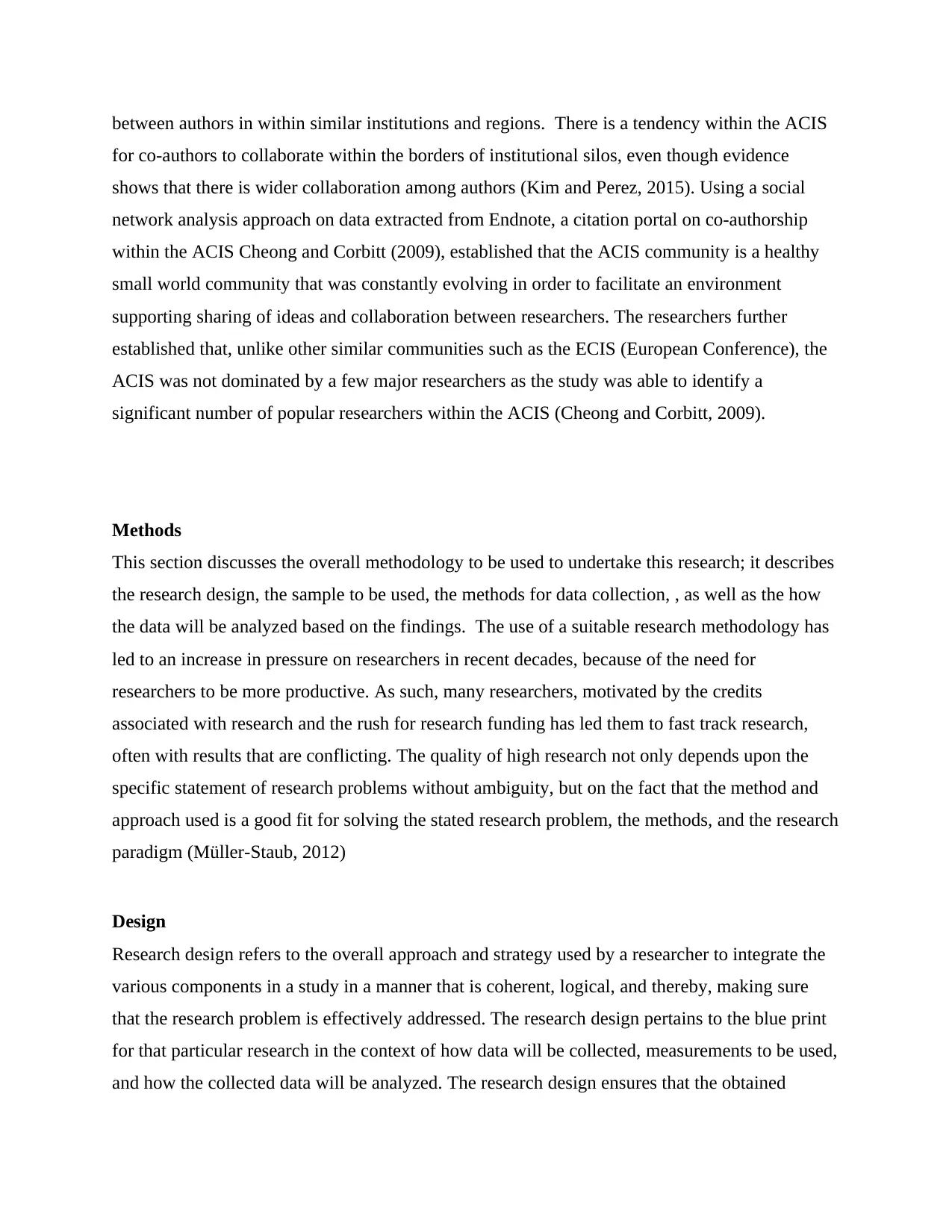
between authors in within similar institutions and regions. There is a tendency within the ACIS
for co-authors to collaborate within the borders of institutional silos, even though evidence
shows that there is wider collaboration among authors (Kim and Perez, 2015). Using a social
network analysis approach on data extracted from Endnote, a citation portal on co-authorship
within the ACIS Cheong and Corbitt (2009), established that the ACIS community is a healthy
small world community that was constantly evolving in order to facilitate an environment
supporting sharing of ideas and collaboration between researchers. The researchers further
established that, unlike other similar communities such as the ECIS (European Conference), the
ACIS was not dominated by a few major researchers as the study was able to identify a
significant number of popular researchers within the ACIS (Cheong and Corbitt, 2009).
Methods
This section discusses the overall methodology to be used to undertake this research; it describes
the research design, the sample to be used, the methods for data collection, , as well as the how
the data will be analyzed based on the findings. The use of a suitable research methodology has
led to an increase in pressure on researchers in recent decades, because of the need for
researchers to be more productive. As such, many researchers, motivated by the credits
associated with research and the rush for research funding has led them to fast track research,
often with results that are conflicting. The quality of high research not only depends upon the
specific statement of research problems without ambiguity, but on the fact that the method and
approach used is a good fit for solving the stated research problem, the methods, and the research
paradigm (Müller-Staub, 2012)
Design
Research design refers to the overall approach and strategy used by a researcher to integrate the
various components in a study in a manner that is coherent, logical, and thereby, making sure
that the research problem is effectively addressed. The research design pertains to the blue print
for that particular research in the context of how data will be collected, measurements to be used,
and how the collected data will be analyzed. The research design ensures that the obtained
for co-authors to collaborate within the borders of institutional silos, even though evidence
shows that there is wider collaboration among authors (Kim and Perez, 2015). Using a social
network analysis approach on data extracted from Endnote, a citation portal on co-authorship
within the ACIS Cheong and Corbitt (2009), established that the ACIS community is a healthy
small world community that was constantly evolving in order to facilitate an environment
supporting sharing of ideas and collaboration between researchers. The researchers further
established that, unlike other similar communities such as the ECIS (European Conference), the
ACIS was not dominated by a few major researchers as the study was able to identify a
significant number of popular researchers within the ACIS (Cheong and Corbitt, 2009).
Methods
This section discusses the overall methodology to be used to undertake this research; it describes
the research design, the sample to be used, the methods for data collection, , as well as the how
the data will be analyzed based on the findings. The use of a suitable research methodology has
led to an increase in pressure on researchers in recent decades, because of the need for
researchers to be more productive. As such, many researchers, motivated by the credits
associated with research and the rush for research funding has led them to fast track research,
often with results that are conflicting. The quality of high research not only depends upon the
specific statement of research problems without ambiguity, but on the fact that the method and
approach used is a good fit for solving the stated research problem, the methods, and the research
paradigm (Müller-Staub, 2012)
Design
Research design refers to the overall approach and strategy used by a researcher to integrate the
various components in a study in a manner that is coherent, logical, and thereby, making sure
that the research problem is effectively addressed. The research design pertains to the blue print
for that particular research in the context of how data will be collected, measurements to be used,
and how the collected data will be analyzed. The research design ensures that the obtained
Paraphrase This Document
Need a fresh take? Get an instant paraphrase of this document with our AI Paraphraser
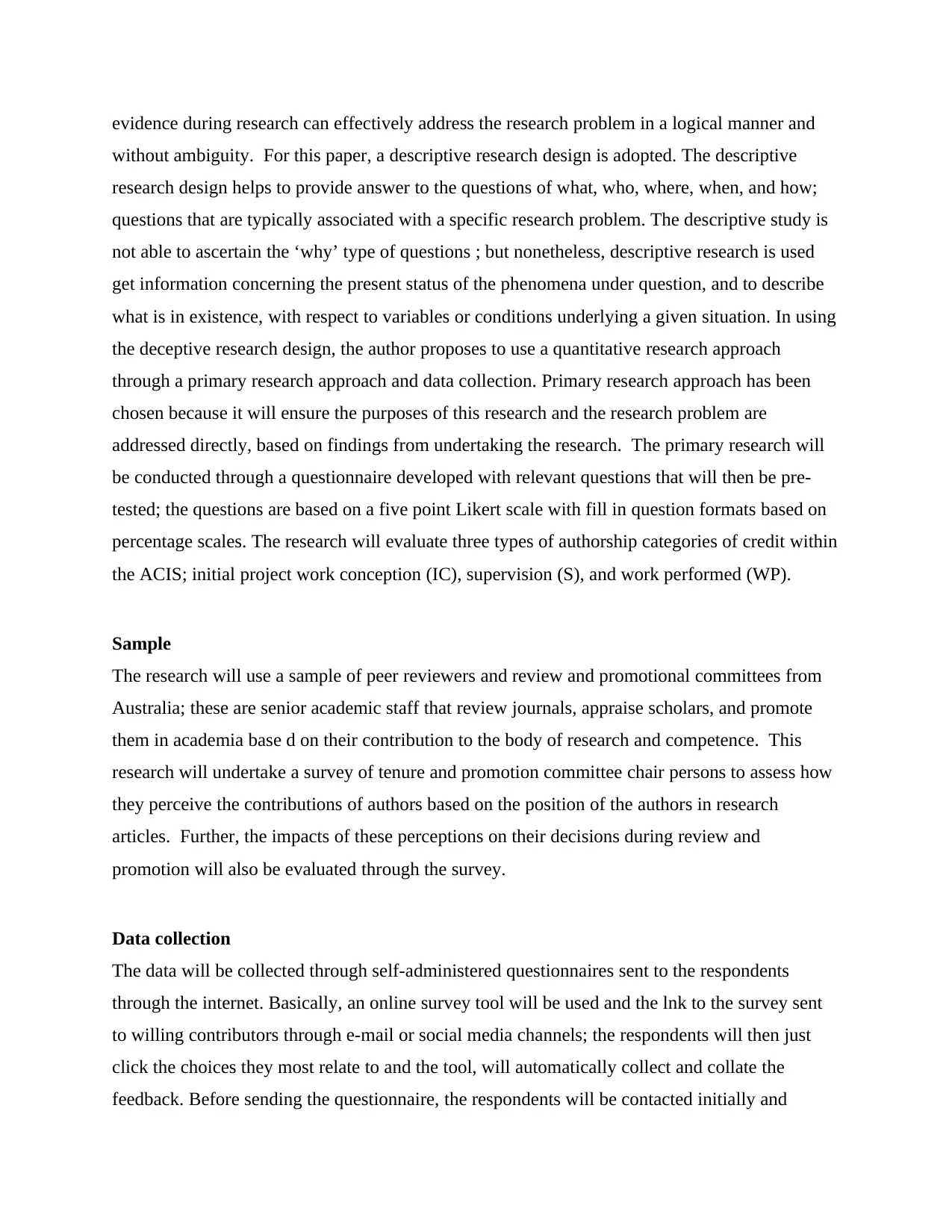
evidence during research can effectively address the research problem in a logical manner and
without ambiguity. For this paper, a descriptive research design is adopted. The descriptive
research design helps to provide answer to the questions of what, who, where, when, and how;
questions that are typically associated with a specific research problem. The descriptive study is
not able to ascertain the ‘why’ type of questions ; but nonetheless, descriptive research is used
get information concerning the present status of the phenomena under question, and to describe
what is in existence, with respect to variables or conditions underlying a given situation. In using
the deceptive research design, the author proposes to use a quantitative research approach
through a primary research approach and data collection. Primary research approach has been
chosen because it will ensure the purposes of this research and the research problem are
addressed directly, based on findings from undertaking the research. The primary research will
be conducted through a questionnaire developed with relevant questions that will then be pre-
tested; the questions are based on a five point Likert scale with fill in question formats based on
percentage scales. The research will evaluate three types of authorship categories of credit within
the ACIS; initial project work conception (IC), supervision (S), and work performed (WP).
Sample
The research will use a sample of peer reviewers and review and promotional committees from
Australia; these are senior academic staff that review journals, appraise scholars, and promote
them in academia base d on their contribution to the body of research and competence. This
research will undertake a survey of tenure and promotion committee chair persons to assess how
they perceive the contributions of authors based on the position of the authors in research
articles. Further, the impacts of these perceptions on their decisions during review and
promotion will also be evaluated through the survey.
Data collection
The data will be collected through self-administered questionnaires sent to the respondents
through the internet. Basically, an online survey tool will be used and the lnk to the survey sent
to willing contributors through e-mail or social media channels; the respondents will then just
click the choices they most relate to and the tool, will automatically collect and collate the
feedback. Before sending the questionnaire, the respondents will be contacted initially and
without ambiguity. For this paper, a descriptive research design is adopted. The descriptive
research design helps to provide answer to the questions of what, who, where, when, and how;
questions that are typically associated with a specific research problem. The descriptive study is
not able to ascertain the ‘why’ type of questions ; but nonetheless, descriptive research is used
get information concerning the present status of the phenomena under question, and to describe
what is in existence, with respect to variables or conditions underlying a given situation. In using
the deceptive research design, the author proposes to use a quantitative research approach
through a primary research approach and data collection. Primary research approach has been
chosen because it will ensure the purposes of this research and the research problem are
addressed directly, based on findings from undertaking the research. The primary research will
be conducted through a questionnaire developed with relevant questions that will then be pre-
tested; the questions are based on a five point Likert scale with fill in question formats based on
percentage scales. The research will evaluate three types of authorship categories of credit within
the ACIS; initial project work conception (IC), supervision (S), and work performed (WP).
Sample
The research will use a sample of peer reviewers and review and promotional committees from
Australia; these are senior academic staff that review journals, appraise scholars, and promote
them in academia base d on their contribution to the body of research and competence. This
research will undertake a survey of tenure and promotion committee chair persons to assess how
they perceive the contributions of authors based on the position of the authors in research
articles. Further, the impacts of these perceptions on their decisions during review and
promotion will also be evaluated through the survey.
Data collection
The data will be collected through self-administered questionnaires sent to the respondents
through the internet. Basically, an online survey tool will be used and the lnk to the survey sent
to willing contributors through e-mail or social media channels; the respondents will then just
click the choices they most relate to and the tool, will automatically collect and collate the
feedback. Before sending the questionnaire, the respondents will be contacted initially and
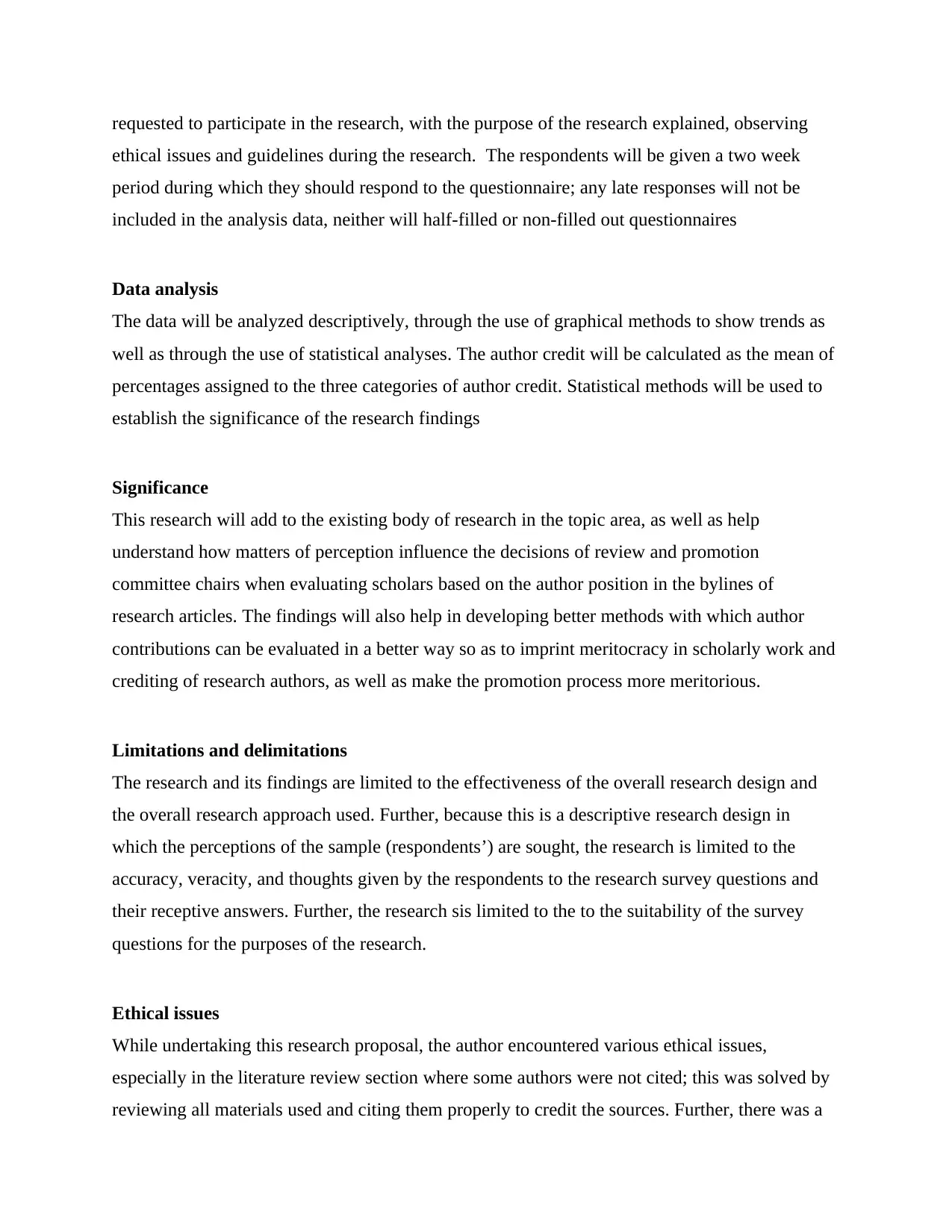
requested to participate in the research, with the purpose of the research explained, observing
ethical issues and guidelines during the research. The respondents will be given a two week
period during which they should respond to the questionnaire; any late responses will not be
included in the analysis data, neither will half-filled or non-filled out questionnaires
Data analysis
The data will be analyzed descriptively, through the use of graphical methods to show trends as
well as through the use of statistical analyses. The author credit will be calculated as the mean of
percentages assigned to the three categories of author credit. Statistical methods will be used to
establish the significance of the research findings
Significance
This research will add to the existing body of research in the topic area, as well as help
understand how matters of perception influence the decisions of review and promotion
committee chairs when evaluating scholars based on the author position in the bylines of
research articles. The findings will also help in developing better methods with which author
contributions can be evaluated in a better way so as to imprint meritocracy in scholarly work and
crediting of research authors, as well as make the promotion process more meritorious.
Limitations and delimitations
The research and its findings are limited to the effectiveness of the overall research design and
the overall research approach used. Further, because this is a descriptive research design in
which the perceptions of the sample (respondents’) are sought, the research is limited to the
accuracy, veracity, and thoughts given by the respondents to the research survey questions and
their receptive answers. Further, the research sis limited to the to the suitability of the survey
questions for the purposes of the research.
Ethical issues
While undertaking this research proposal, the author encountered various ethical issues,
especially in the literature review section where some authors were not cited; this was solved by
reviewing all materials used and citing them properly to credit the sources. Further, there was a
ethical issues and guidelines during the research. The respondents will be given a two week
period during which they should respond to the questionnaire; any late responses will not be
included in the analysis data, neither will half-filled or non-filled out questionnaires
Data analysis
The data will be analyzed descriptively, through the use of graphical methods to show trends as
well as through the use of statistical analyses. The author credit will be calculated as the mean of
percentages assigned to the three categories of author credit. Statistical methods will be used to
establish the significance of the research findings
Significance
This research will add to the existing body of research in the topic area, as well as help
understand how matters of perception influence the decisions of review and promotion
committee chairs when evaluating scholars based on the author position in the bylines of
research articles. The findings will also help in developing better methods with which author
contributions can be evaluated in a better way so as to imprint meritocracy in scholarly work and
crediting of research authors, as well as make the promotion process more meritorious.
Limitations and delimitations
The research and its findings are limited to the effectiveness of the overall research design and
the overall research approach used. Further, because this is a descriptive research design in
which the perceptions of the sample (respondents’) are sought, the research is limited to the
accuracy, veracity, and thoughts given by the respondents to the research survey questions and
their receptive answers. Further, the research sis limited to the to the suitability of the survey
questions for the purposes of the research.
Ethical issues
While undertaking this research proposal, the author encountered various ethical issues,
especially in the literature review section where some authors were not cited; this was solved by
reviewing all materials used and citing them properly to credit the sources. Further, there was a
⊘ This is a preview!⊘
Do you want full access?
Subscribe today to unlock all pages.

Trusted by 1+ million students worldwide
1 out of 16
Related Documents
Your All-in-One AI-Powered Toolkit for Academic Success.
+13062052269
info@desklib.com
Available 24*7 on WhatsApp / Email
![[object Object]](/_next/static/media/star-bottom.7253800d.svg)
Unlock your academic potential
Copyright © 2020–2025 A2Z Services. All Rights Reserved. Developed and managed by ZUCOL.





